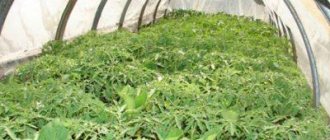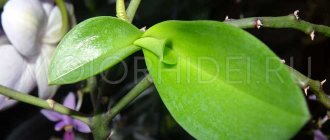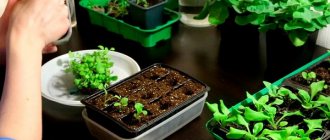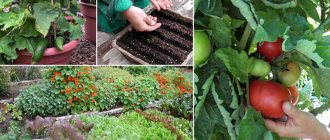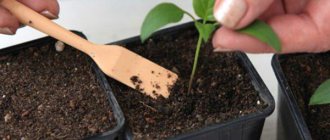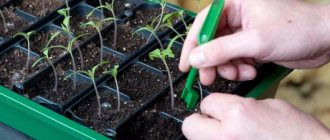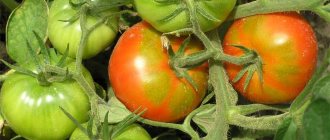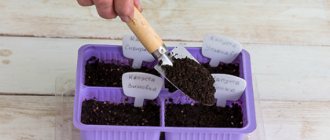Just a week ago, the seedlings stood cheerfully on the window, but today, once in the greenhouse, they drooped and turned yellow? She probably did not tolerate the transplant well, and you will have to help her adapt to the new place so as not to lose the entire harvest.
In order for seedlings to feel comfortable in a greenhouse, hotbed or open ground after planting, they must be prepared for moving. We have repeatedly written about hardening, the correct watering regime and fertilizing, which will help young bushes adapt more easily.
- Caring for seedlings after picking - everything about supplementary lighting, watering, fertilizing, treatment for diseases
How to feed and water tomatoes, peppers, eggplants and petunia after picking?
But what if you seem to have done everything correctly, but the result is still not satisfactory?
Seedlings wither after planting
Partial wilting of leaves on seedlings after transplantation is normal. No matter how hard you try, slight injury to the roots will still occur, and changes in temperature and soil composition will do the rest. For several days (from 5 to 14), the plant will become less able to absorb moisture, and the leaves will actively evaporate it, trying to create a comfortable microclimate around it.
What to do : shading the seedlings for the first two weeks and providing them with a comfortable temperature will help minimize the consequences. But you shouldn’t be overzealous with watering - torn roots will not be able to absorb water, and you will only flood the soil, depriving the bushes of air.
Excess nitrogen in the soil
The plant must be fed regularly. This is done with the help of various fertilizers and microelements. However, excessive amounts of nitrogen can cause rapid growth of green mass and wilting of the tops of tomatoes.
Excessive watering helps solve this problem, however, due to excess moisture, the plant can become infected with fungus. To prevent this problem, fertilizers must be applied strictly according to the instructions.
Spraying with calcium sulfate (one teaspoon per liter of water) will also help balance out excessive amounts of nitrogen. The use of ash also gives good results (one glass per bucket of water).
Seedlings turn yellow after planting
Yellowing of the leaves of seedlings can occur from too bright lighting, excess nitrogen (too much organic fertilizer added to the soil shortly before planting), improper watering or increased soil acidity. To avoid this, seedlings should be planted only after a week of adaptation and try to maintain conditions (temperature and humidity) in the new location that are not very different from those to which they are accustomed.
What to do : if after transplanting the leaves on the seedlings turn yellow, protect it from direct sunlight, ensure a stable daytime temperature of no higher than 27°C and a night temperature of no lower than 15°C, water it no more than 2 times a week and only with settled warm water.
- Why do tomato seedlings turn yellow, dry and curl?
Let's understand the reasons for changes in the appearance of tomato seedling leaves.
Improper care of tomatoes leads to serious problems:
1. Tomatoes are cracking. The number one reason for cracked tomatoes is uneven watering. The soil stays dry for a long time until it becomes cracked, and then you fill the bed with water. Or after long rains, hellish heat sets in, but there is no watering of the garden bed. The solution to the problem is to provide the tomato with proper watering. The cracks themselves are not dangerous, but fungal spores or parasites can enter the tomato through them. After a while, the crack will heal and the risk of tomato disease will disappear. The taste of a cracked fruit is much worse. Sometimes there are cracks on tomato fruits that are not related to watering; they look like tears. They are popularly called “cat’s face” or “mother-in-law’s smile” and are found on the lower fruits. They are caused by excess nitrogen or incorrect use of pollination stimulants. Blossom blossom may develop and the tomato leaves will become covered with extensive burns. A critical overdose of nitrogen can lead to the death of the plant.
2. Soil phytotoxicity. With excessive use of fertilizing and infatuation with pesticides, we get the opposite effect. The soil is so saturated with substances that it becomes harmful to tomatoes. Poisoning affects you in different ways. More often, gray spots with a purple tint appear on the leaves; they dry out and, to the already spotted color of the leaves, dry brown areas are added. Observing the overall picture, you will notice that the spots are rising from the roots, along with a toxic cocktail of fertilizers and pesticides being absorbed from the soil.
3. Silvery spots. Increasingly, gardeners are asking questions about silvery spots of unknown origin covering tomato leaves. After much study, professional experts agreed that the mysterious symptoms were caused by a physiological disturbance that had occurred in the plant. Failure may be caused by sudden temperature changes. The reason for hybrid tomatoes is said to be genetic deviations that were not taken into account as a result of the hasty work of breeders.
4. Oedema or edema. Most often observed in a greenhouse. This phenomenon looks unpleasant - the leaves and stem are covered with raised spots, as if the plant is covered in white mold. The spots are located either in separate groups or almost completely. It seems that the unfortunate tomato has contracted a contagious disease. The real cause of spots is simple - swelling. Yes, they occur not only in people, but also in tomatoes. This occurs when there is an excess of moisture in the leaves, and intra-root pressure continues to pump them with water. The tomato greens are so crowded that the leaves become warped and deformed. It happens that the swelling bursts from the pressure of moisture. It's easy to assume that the problem is overwatering. But this is not always the case. The reason is the difference in soil and air temperatures in cool weather. To eliminate swelling in a tomato, it is necessary to carry out a series of procedures aimed at establishing normal humidity, increasing air temperature and sufficient lighting, if necessary.
Seedlings lose leaves after planting
The falling of the lower leaves of seedlings is a natural process, and you should not be afraid of it. The cotyledon leaves and the first pair may turn yellow and fall off without damaging the entire bush. But if the remaining leaves begin to turn yellow and crumble, it means that the seedlings have a serious problem. Most likely, the plant is sick or suffering from pests that gnaw at the roots.
What to do : if there are 1-2 bushes with falling leaves, dig them up, disinfect the soil, and burn the plants themselves. If the problem is larger, look for the cause. To begin, remove several seedlings from the ground and examine their roots. If they are rotten, remove the affected parts, sprinkle the cuts with chiseled charcoal, disinfect the holes with potassium permanganate (0.5 g of powder per 100 ml of water) and replant them. If beetle larvae or other voracious pests are found in the holes, select them manually or spill the soil with special preparations.
How to feed tomatoes in a greenhouse?
- Don't forget about feeding tomatoes in the greenhouse. Fertilizers must be applied from the moment the first ovary is formed. Depending on the growth phase, different means are used: liquid mullein, potassium sulfate, wood ash and superphosphate.
- During the growing season, you need to carry out 4 root feedings. The first is recommended to be done 20 days after planting the seedlings in a permanent place. To do this, take 1 tbsp. l. nitrophoska, 500 ml of liquid mullein and 10 liters of water at the rate of 1 liter of fertilizer for each plant. The second feeding is carried out 10 days after the first. To do this, take 1 tbsp. l. complete fertilizer and 1 tsp. potassium sulfate per 10 liters of water at the rate of 5 liters per 1 sq.m. Carry out the third feeding 12 days after the second. To do this, take 1 tbsp. l. superphosphate and 2 tbsp. l. wood ash per 10 liters of water at the rate of 8 liters per 1 sq.m.
- When the plant begins to bear fruit, it will need to be fertilized with the following composition: 1 tsp. sodium humate, 2 tbsp. l. superphosphate per 10 liters of water. This composition should be watered at the rate of 5 liters per 1 sq.m. This fertilizing accelerates the ripening of fruits.
The seedlings dropped flowers after planting
If you made a slight mistake with the timing of planting the seedlings, and they bloomed right on the windowsill, the move must be carried out especially carefully. Flowers are the most fragile thing that young plants have, and they are the first to fall off from stress. Most likely, some of the flowers will fall off during transplantation or will not set an ovary. Especially if the seedlings have not been hardened or the composition of the soil in the pots and beds has fundamental differences.
What to do : don’t worry about the loss, the loss of some flowers is not critical. After several days from planting, treat the plants with Epin Extra according to the instructions to minimize stress levels.
- What to do if the seedlings bloom before planting
The spring weather this year is not pleasant, and the seedlings are blooming right on the window, before they can be planted? It's time to take action!
The main reasons for plant wilting
In order not to say goodbye to the idea of growing tomatoes in your own garden bed, you must first find out why tomato seedlings wither and fall. By identifying the causes, you can help the plants restore their former health.
Among the main causes of wilting are:
- violations of agricultural technology;
- infection with diseases.
Often it is poor care and oversight during cultivation that causes tomato seedlings to wither. One should also not exclude infection by diseases as a cause of tomato wilting; even such young plants can suffer from this. If you find out in time why the seedlings began to wither, you can improve the situation and saving the young bushes will not be difficult.
The seedlings changed color after planting
But a change in the color of leaves and stems in seedlings is a dangerous sign. Violet, red, gray and brown shades should alert the gardener. Thus, plants are literally screaming about an acute lack of certain nutrients in the soil. Most often they are deficient in phosphorus, potassium or nitrogen, but they may also be deficient in boron or iron.
- Nitrogen, phosphorus, potassium - signs of deficiency and excess in plants
What do excess or deficiency of nitrogen, phosphorus and potassium lead to? Find out in our infographic!
Diseases caused by pathogenic microorganisms
Such diseases are the most dangerous for plant crops. Can be transmitted through soil, parasites or already present on tomato seeds. Bacteria can manifest themselves either immediately or remain in “sleeping” mode. To avoid plant diseases, you should not allow:
- Temperatures above 28 degrees Celsius.
- High soil moisture.
- Stagnation of water in planting pots.
Reference . To prevent bacterial diseases, do not neglect thorough disinfection of soil and seeds. Any copper-containing solution is suitable for treating seedlings.
The most dangerous bacterial disease can be considered “bacterial cancer” . The disease destroys the vessels of the plant. Externally it appears as:
- The appearance of ulcers along the entire stem trunk.
- Complete death of seedlings.
Treatment is impossible. The diseased plant must be removed and burned. The soil in which the seedlings were located is no longer used. This disease can be prevented by treating seeds with 40 percent formaldehyde (calculating 1 part solution - 300 parts water).
spotting
Buraya
This disease has the following symptoms:
- Small yellow spots on the outside of the leaves.
- Rapid growth of these spots.
- White coating on the inside of the leaf.
- Dying of seedling leaves.
The disease can be cured by spraying cuprosil, copper sulfate or any other copper-containing drug.
The seedlings became covered in spots after planting
The appearance of spots of different colors and shapes on the leaves of transplanted seedlings can indicate three things at once. Firstly, this is how a lack of nutrients is expressed. Brown spots indicate a lack of potassium, blue-green spots indicate a lack of phosphorus, and red spots indicate a lack of nitrogen. Secondly, some insects leave such traces. For example, the tomato rust mite shows its presence with brown spots on the leaves, the onion secretive proboscis, tobacco whitefly, soldier bug and melon aphid - yellow, California thrips - silver. And finally, the spots can be burns left by drops of water falling on the leaves. This happens if you water the seedlings not at the roots on a sunny day.
What to do : carefully inspect the plantings for pests. If no signs of their presence are detected, carry out corrective feeding with the missing nutrient. If insects are found, take action.
Prevention measures
To protect tomatoes and the future harvest from diseases and pests, you need to adhere to several simple, but extremely important, rules. Here is what advice experts give on this matter:
- plant only healthy plants, select only strong seedlings;
- take into account the fertility of the soil before planting, since a lack of nutrients can be one of the causes of diseases;
- work with plants as carefully as possible, avoiding unintentional damage, breaks or cuts;
- during planting, you can put a little dried nettle in the hole; it is believed that nettle promotes the healthy growth and development of tomatoes;
- take into account the time of planting tomatoes, since these plants are very sensitive to weather conditions;
- It is recommended to plant several different varieties of tomatoes at the same time;
- Ensure that distance is maintained between bushes.
Experts also advise not to plant tomatoes in the same place every year, but to take a break for three to four years. If the greenhouse is dedicated solely to tomatoes, it will need to either completely change the soil every year or move it to another location. In addition, you need to remember that the soil after diseased plants must be disinfected to avoid the return of diseases.
Holes appeared on the leaves of the seedlings after planting
If small holes of different shapes are found on the leaves of the seedlings soon after planting, it means that someone has been waiting for this moment even more than you. You probably did not properly treat the greenhouse or greenhouse, and insect pests have appeared in it. The most common leaf-eating insects in our dachas are cutworms, brooms, cruciferous flea beetles, cabbage caterpillars, shield moths and slugs.
What to do : carefully inspect the plantings and the ground underneath them. If you find a pest, try to identify it, and then use special means to control it.
- All garden pests in tables with descriptions, photos and control measures
We have compiled a “dossier” for you on each pest - save this collection!
As you can see, planting seedlings in the ground is not yet a reason to lower your guard. The most important work is just beginning, and you still have a lot of work to do before the harvest and well-deserved rest.
Pest damage
Pests rarely attack tomatoes, but it still happens with large plantings and growing in a greenhouse. Most often these are whiteflies, spider mites, and aphids. The foliage of a plant affected by these pests is curled upward.
To identify the presence of insect pests, it is enough to take a closer look at the leaves from the outside and inside.
Whitefly. This insect is white in color and feeds on plant sap. Most often it affects plants in greenhouses and greenhouses. One of the effective methods of combating whitefly is spraying tomatoes with garlic infusion.
Spider mites appear in dry weather. Its web is almost invisible, and the pest itself hides on the lower leaves. The tick feeds on plant sap. If it is detected, the tomatoes are sprayed with alcohol or chemicals are used, for example, karbofos.
Black aphids penetrate into the axils of the leaves, which is why they cannot be immediately noticed. Aphids feed on tomato juice and inject a special substance, which is the reason why the leaves of tomatoes in the greenhouse curl. Gardeners ask what to do when black aphids appear; the answer is simple; careful spraying with insecticides (Aktellik, Biotlin, Karbofos) is necessary. If there are fruits on the plants, you can spray them with infusions of tobacco, marigolds, ash, wormwood, and mustard.
Bacteria, viruses and fungi can cause diseases in tomatoes, the symptoms of which are curled leaves.
Such diseases include:
- Bacterial cancer (the first sign is leaves curling towards the bottom, followed by wilting, discoloration and falling, and cracks appear on the trunks); Infected plants are cut off, and the cut site is lubricated with copper oxychloride. The tops are burned away from the site, and the remaining plants in a 10-meter zone are sprayed with HOM.
- Tobacco mosaic virus (leaf curling with a mosaic pattern in which light and dark green alternate). Prevention of the disease is crop rotation, disinfection of seeds, boxes and tools. In case of illness, tomatoes are treated with skim milk diluted in water at a rate of 1:10;
- Verticillium wilt (appears first at the bottom of the plant, the leaves curl, lose turgor and wither); Soil treatment with trichodermin or potassium humate.
- Fusarium (the lower leaves are the first to be affected, they curl into a tube, become light green in color, the crown of the plant withers, and the basal neck acquires a pink tint); Treatment of plantings with Fitosporin-M and Agat-25K.
After reading this article, you will understand that standard recommendations on what to do if the leaves of a tomato curl in a greenhouse are simply impossible. Having discovered such leaves, you need to accurately examine the environment in which the tomatoes grow, remember what fertilizing was done and their quantity, and also inspect the plants for the presence of pests and diseases.
How to grow Pinocchio tomatoes on a windowsill and in a greenhouse?
Why do tomato bushes grow poorly and turn yellow?
How to cure tomatoes from diseases?
Tomato varieties for the harsh conditions of Siberia
Violation of agricultural technology
Unsuitable soil
Properly selected soil is of great importance. If the seeds are sown in heavy clay soil or it has a low pH level and increased acidity, the young plants begin to wither. And after a while they dry out and die. This is due to the fact that with a heavy compacted soil mixture, gas exchange is disrupted, the root system develops poorly, and the plant does not receive enough nutrients. And a low pH level leads to a high level of salts in the soil, which attract microelements, which does not allow seedlings to receive adequate nutrition.
Solution
In such a situation, the first thing to do is replant it in suitable soil. For tomatoes, well-drained neutral soil with a pH level of 5.5-7 is suitable. The composition should include:
- leaf soil;
- lowland peat;
- agroperlite or vermiculite;
- sand.
You can purchase a universal soil mixture. Before transplanting, it is worth disinfecting it so as not to expose it to the risk of infection. The soil should be spilled with a weak solution of potassium permanganate or cauterized in the oven at 90 °C for half an hour. The sprouts are carefully transplanted into the prepared soil and lightly watered.
Thickened plantings
With ignorance or fear that the seeds may not germinate well, an inexperienced gardener has a desire to plant more seeds in a container. As a result, a large number of tomatoes grow in containers. The plants are crowded, they do not have enough light and space, they begin to stretch out. The stems become thin and the leaves wither.
Solution
Plants need to remove excess greenery
To save tomatoes, it is enough to thin them or pick them. If such a quantity of what has sprouted is not required, then simply cut through the planting, removing weaker plants. In the case when each bush is valuable, then they pick and transplant some of the plants into additional containers.
Insufficient lighting
At the stage of growing seedlings, sufficient lighting is a very important factor. When sowing seeds early in late winter or early spring, lack of light is a very common problem. Since daylight hours are still short, and the growth of healthy seedlings requires at least 8-10 hours of lighting. In poor lighting, the stems become thinner, moisture becomes thinner and nutrients do not move well through the vascular system, and as a result, the lower leaves of the tomatoes begin to wither, and then the rest.
Solution
To improve the situation, you need to keep the tomatoes on the most illuminated windowsill. The south or east side is better. But a greater effect can be achieved if illuminated with photo lamps or fluorescent lamps. They provide lighting that is as close to natural as possible.
Temperature violation
Even though tomatoes love warmth, high temperatures often cause the plants to shut down and die. Temperatures on a windowsill or greenhouse above 35°C can cause irreversible damage.
Temperature drops below 15 °C have no less detrimental effects. When the temperature is low, tomatoes are unable to absorb nutrients. There is a cessation of receipt:
- phosphorus at temperatures below 15 °C;
- nitrogen at temperatures below 10°C.
Solution
It is necessary to adjust the temperature to the optimal temperature for the growth of tomatoes, and it should be within 18-25 ° C.
High temperatures during the growing period of seedlings are rare. But, if overheating occurs, the room where it grows should be ventilated in order to stabilize the temperature or remove the seedlings to a more suitable place.
At low temperatures, provide additional heating. You can move the seedlings to a more suitable place. Make sure there are no drafts, which can also cause a drop in temperature.
Improper watering
Wilting can also be caused by improper watering. Tomatoes are negatively affected by both lack and excess moisture. Even short-term drying out of the soil leads to wilting of the leaves. But a long absence of watering can completely destroy the seedlings.
Overwatering can cause just as much damage. Excess moisture leads not only to lethargy, but also to rotting of the roots. Also, excessive watering promotes the development of pathogens and fungi.
Solution
Improper watering can have a detrimental effect on tomatoes.
If the seedlings have wilted due to insufficient watering, in order to restore them, it will be enough to carefully water them. What you shouldn’t do is water the seedlings too much right away. It is necessary to moisten the soil gradually in several stages. When proper regular watering is resumed, the condition of the plants will completely stabilize.
If the tomatoes have wilted and died due to severe overwatering, proceed as follows:
- Free the sprouts from wet soil
- Replant into slightly moistened fresh soil
- Gently water each plant with a weak solution of magnesium permanganate.
- Treat the leaves with a solution of Epin or another growth stimulant.
Infection with diseases
Tomatoes at the seedling stage can also be affected by diseases. The cause of infection is seeds or soil. And not proper care stimulates their development. The most common cause of leaf wilting is the following diseases:
Fusarium wilt (fusarium wilt)
A fungal disease that affects both adult bushes and young seedlings. The causative agent of fusarium is fungal bacteria of the genus Fusarium. Infection occurs through spores that remain viable in the soil for several years. With fusarium, the root is primarily affected and as a result, you can observe that the seedlings become lethargic and fall.
Solution
The disease is complex and the fight against it does not always bring positive results. If fusarium is diagnosed, tomatoes are treated with Trichodermin. Spray the solution over the leaf. They also spill soil on them. Treatment is carried out 2-3 times, every 10 days.
